Gov. Phil Bryant & FC Commissioner Mignon Clyburn Visits NSMC
Governor Bryant partners with UMMC, GE Healthcare, Intel-GE Care Innovations, North Sunflower Medical Center and Cspire to launch Diabetes Telehealth Network.
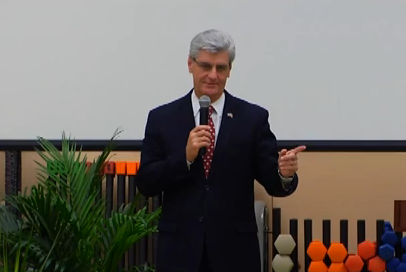
Governor Bryant partners with UMMC, GE Healthcare, Intel-GE Care Innovations, North Sunflower Medical Center and Cspire to launch Diabetes Telehealth Network.
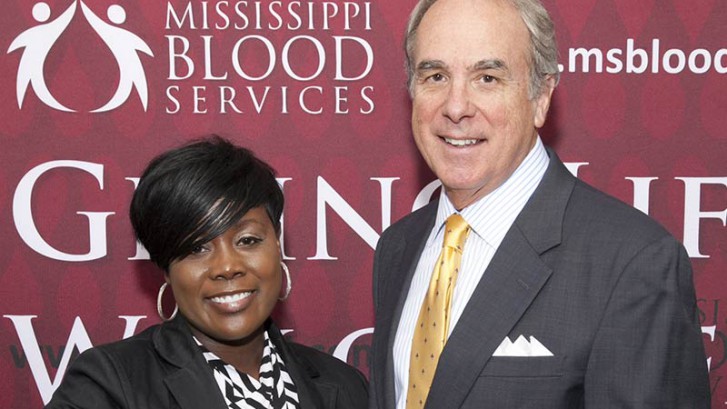
North Sunflower Medical Center in Ruleville is committed to having four drives a year; they also encourage ALL who are employed or associated with North Sunflower Medical to donate as often as possible.
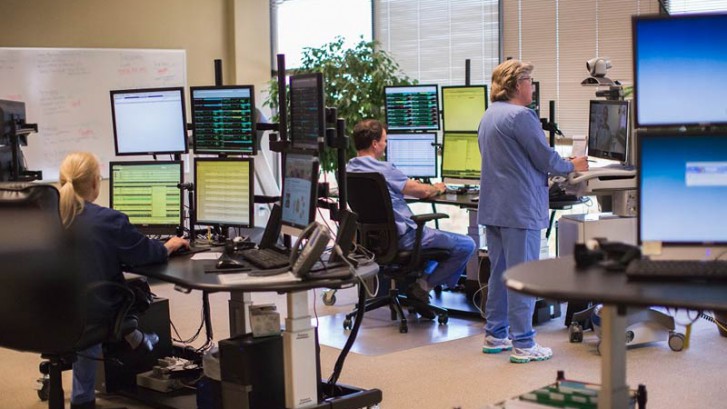
Kristi Henderson, D.N.P. isn’t going to sugar coat things when talking about where her home state, Mississippi, ranks on various measures of health.

Holographic house calls are probably not in the cards, at least in the near future.
But the potential of telehealth to connect patients to their health care team between office visits and expand the resources available to primary care providers is tremendous.
“We have to be resourceful,” said Nurse Practitioner Kristi Henderson, chief telehealth and innovation officer for the University of Mississippi Medical Center (UMMC) in Jackson. “Technology can bring people together in more efficient ways.”
Telehealth encompasses a broad range of technology and can connect patients with their health care team or link health care providers with each other. In addition to video conferencing capability, medical instruments like stethoscopes have gotten high-tech makeovers to allow a nurse or doctor across the state or across the country to hear a patient’s heart beat or look into their ears.
A UMMC telehealth command center in north Jackson is staffed 24/7. There, specialists are connected with hospitals and clinics and provide backup monitoring for ICUs, ERs and post-surgical units.
FILLING GAPS
For primary care, telehealth is about filling gaps, not replacing the primary care provider.
In theory, the technology is there to provide remote primary care. A doctor can examine a patient with a trained assistant handling the diagnostic tools. But the human connection that may be the most effective part of the primary care provider-patient dynamic would be lost.
“Relationships are as important to health as medicine,” said Marilyn Sumerford, the executive director of Access Family Health.
Telehealth can bridge the miles for rural patients and their providers by putting them in touch with specialists without having to travel outside their home communities. A number of hospitals and clinics are already using the special video conferencing capabilities to connect to specialists in Jackson and elsewhere.
“It can keep them in their medical home,” Henderson said.
Telehealth has potential to add real-time collaboration, creating a web of support for mid-level providers in the field. Under the current Mississippi regulation, the Board of Medical Licensure and Board of Nursing require nurse practitioners and physician assistants to work in collaboration with or under supervision of physicians. Incorporating telehealth connectivity into the rules could be a boon to rural clinics who struggle with meeting the requirements, like the one that requires a nurse practitioner to be located within 15 miles of a collaborating physician.
“How do we allow people to work at the highest level of their license?” Henderson said. “It’s not a lower standard of care, just different.”
OUTSIDE THE OFFICE
Telehealth opens opportunities for cost-effective medical coaching, especially with chronic conditions, which are a key focus for primary care. It allows the health care team to actively guide patients. When it comes to managing complex conditions, like diabetes or congestive heart failure, the health care team can coach, but it’s the person who has to do the daily work to control the disease.
“Until we start getting patients engaged, we’re not going to get any huge improvements in outcomes,” Henderson said.
Through a public-private partnership, UMMC Center for Telehealth has been working with diabetes patients in Sunflower County. The patients are using special Internet-accessible tablets that automatically capture their weight, blood pressure and blood sugar levels. The patients also use the tablets to share what’s going on physically, emotionally and psychologically with their health care providers in Sunflower County, UMMC specialists and the telehealth center.
The daily information keeps the patients’ health care team in the loop and allows them to correct problems before they become a crisis that could require a trip to the hospital.
The early results show improvement in diabetes management and patients are engaged. One woman said she learned more about her diabetes in a few weeks with the tablet than she had in 15 years.
“For some of them, it’s the first time their diabetes has been controlled, ever,” Henderson said.
Not all telehealth involves talking to a provider over a live video connection. Just like in Mississippi, long distances can separate hospital and home. Oregon Health and Sciences University is using the Health Buddy device to connect with newly discharged congestive heart failure patients who live outside of the Portland metro area.
“With heart failure, self-care is huge, and it changes outcomes,” said Nurse Practitioner Jayne Mitchell, who works with heart failure patients and makes sure they are connected with a primary care physician for follow up.
The device, about the size of a hardback novel, has a small screen and can hook into a phone line or cable connection. It’s easy to use and secure. Each day, the patient puts in weight, heart rate and blood pressure.
The device mixes in trivia questions and checks for possible symptoms. It also quizzes patients to gauge their heart failure management knowledge.
Back at OHSU, Mitchell gets red flags if the patients start showing signs of trouble, like a weight gain that can signal fluid retention. Those patients get a call from Mitchell, who can help them make adjustments to get back on track. The program is set up so the data also gets pushed out to the patient’s primary care provider.
They monitor the patients for 30 days. The early results show fewer of the Health Buddy patients ended up being re-hospitalized within 30 days – less than 20 percent compared with a national average of 24.7 percent.
“There’s a big interest in how to transition patients safely,” said Jean McCormick, a nurse educator who works with OHSU Telehealth. “I think we’re going to see this being used more and more.”
BUILDING ON PROMISE
Population health needs are driving the innovation, but patients need a personal connection to make the changes.
“Call centers are not going to get results,” Mitchell said. “It’s going back to the community of care. They know you. They care about you.”
Henderson wants to see Mississippi embrace telehealth technology and build the infrastructure that opens opportunities to all Mississippi providers. Mississippi law allows physicians to bill for telehealth visits just like office visits.
“My hope is that Mississippi providers will develop a network that is community-based and culturally sensitive,” Henderson said. “I don’t want us to miss the opportunity. National companies are already marketing here.”
Henderson’s biggest fear is that Mississippi ends up with multiple models and proprietary systems that don’t connect with each other, as when different train tracks used a variety of gauges at the dawn of the railroad era.
“It needs to be streamlined with the same network,” Henderson said.
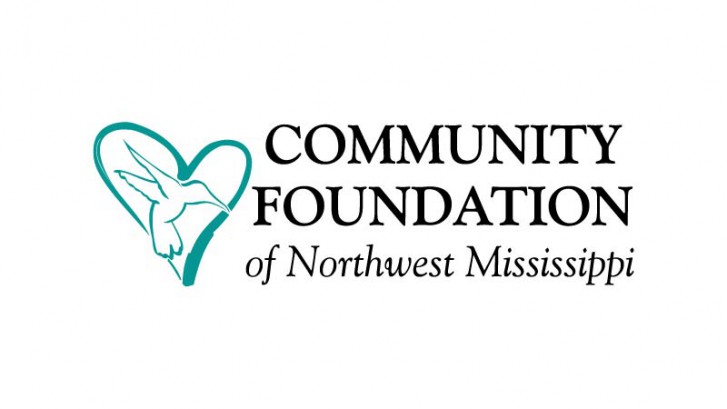
The Community Foundation of Northwest Mississippi has named its Community Stars winners, honoring organizations and individuals who have contributed to their communities in the 11-county Northwest Mississippi region served by the nonprofit organization.
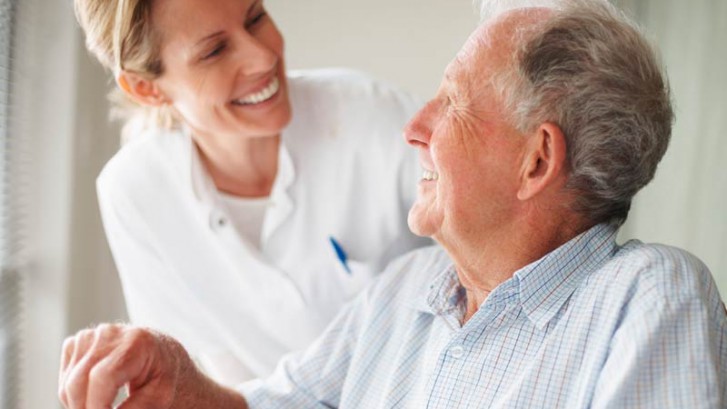
Health IT leaders are finding it difficult to define care management technology because they’re finding it difficult to define care management
It seems as though no one can clearly define care management technology.
Many see care management and the technologies that enable it in direct correlation with population health management. In that sense, care management could be described as the process of analyzing, identifying, monitoring, and improving the care of specific patients within a vulnerable population.
Yet as Dave Levin, M.D., CEO of health IT consultancy Tres Rios Group, and other observers note, this overall concept in itself is comprised of many technologies and stakeholders. In other words, care management technology can’t be easily defined because care management is probably too complex to be put in a single box.
There are consumer-facing technologies, analytics tools, and physician dashboards that service diverse groups of patients, payers, and providers. Experts agree that all of these elements and more, comprise care management.
“I think we have plenty of technologies to enable |care management!, whether we’re talking about analytics and data aggregation and dashboards or the connectivity tools. They are out there,” Dr. Levin says. “The challenge in front of us is to have a better understanding of the full cycle of this kind of care management. It’s not just identification and stratification; it’s about outreach, intervention and engagement too.”
Whatever it is, it seems to be the future of healthcare-at least, according to Markets and Markets, a Dallas-based research firm, which predicted explosive growth for the care management software industry over the next five years, culminating in a value of $7.3 billion in 2018. That would be billion, with a b. Markets and Markets says the value-based legislative reforms of the Affordable Care Act (ACA) and an aging population are the primary drivers of this growth.
At the same time, integrated care networks are popping up across the country with payers and providers entering into unlikely alliances to get in on the action. This has led to an investment in care management technologies, whether it is analytics, telehealth, dashboards, or something else. Investments have come from payers and providers, but mainly the former. Levin notes that providers don’t yet have the experience, while a recent survey of payers from Framingham, Mass.-based IDC Health Insights indicates that more than half of payers are investing into care management applications.
This wave of interest and investment in these technologies, regardless of where it is coming from, has led to a wide range of opinions and feedback on what works and what doesn’t. In Richmond, Va., a physician-hospital organization (PHO) by the name of inHEALTH formed in the mid-1990s, during the previous managed care era, 20 years before risk-based contracts and care management became trendy. The PHO, led by CEO Michael Matthews, has sustained itself by providing health IT and other services related to care management programs.
Go beyond the limits of traditional estate planning.
To Matthews and inHEALTH CMO Stephen Cavalieri, M.D., the most important element in a care management program is successful transitions of care. For their group, this has been accomplished through data exchange, encounter alerts, and secure messaging. inHEALTH has a health information exchange subsidiary, MedVirginia, that it uses to accomplish this. From there, inHEALTH utilizes an analytics system (from the Dallas-based Phytel) that helps determine which patients have the highest risk.
“What population health and analytics tools can do is give you the visibility to understand the patient in between [doctor encounters] and healthcare episodes. When you tie in clinical events [through the EMR] with the type of workstation the care manager has, and also can connect in claims information. which we have access to…a lot of it is blending those information sources and creating this tapestry that we can act on in a complimentary way to what the physician is doing,” Matthews says.
Or to sum it up, as Cavalieri says, “The holy grail is interoperability.” Levin affirms that potential data interoperability problems are a “huge boulder sitting in the way” of any successful care management program. If different sets of data can’t interact in and out of the provider’s workflow, he says, the program is going to have a high failure rate.
Indeed, many burgeoning care management programs rely on interoperable analytics software, which is able to connect payer and provider data and spit out actionable information on high-risk patients. It’s the reason why integrated care networks, like the ones at the Danville, Pa.-based Geisinger Health System and the Oakland-based Kaiser Permanente, have been successful in care management for a long time.
Still, as Greg McGovern, a New Yorkbased director of technology and innovation at the Denver-based Aspen Advisors puts it, what works in one place isn’t guaranteed to work in another. “When you’ve seen one integrated care network, you’ve seen one. Every market is different,” he says.
Many burgeoning programs are using different remote technologies to enable care management through patient engagement. CareMore, a Medicare health payer based in Cerritos, Calif., is centered on a model that provides proactive, risk-based care management plans to high-risk elderly populations. According to Scott Mancuso, M.D., senior medical officer, the company has invested in several remote monitoring technologies as well as telemedicine to care for patients at home.
“We’ve made investments in congestive heart monitoring, hypertension monitoring, COPD monitoring of oxygen saturations. Those are things we’ve been doing for years. More recently, we implemented video into the patient’s home. That video goes far be- yond the reach of physicians, it goes out to social work case managers and pharmacy workers,” l)r. Mancuso says.
Social Security Closing Secrets of $10M Producers.
Telemedicine is one of the technologies of choice for leaders of a diabetes care management program at the University of Mississippi Medical Center (UMMC). The medical center is teaming with the State of Mississippi, GE-Intel care management software vendor, Care Innovations, and rural hospital North Sunflower Medical Center to improve care for diabetics in Ruleville, Miss. Clinicians at UMMC connect with their rural counterparts and the patients through a telemedicine platform. Furthermore, patients in the program are managed through a cloud-based platform. (See sidebar.)
While no one would claim that the various care management tools on the market have fully matured, many are looking past the technology itself in their critical analyses of the emerging philosophy. Steve Krupa, managing partner at the New York City-based venture capital firm Psilos Group, says that the biggest hurdles of implementing care management technology isn’t the technology, it’s the lack of a business case for participation in a care management program.
“From the health insurance companies’ point-of-view, |implementing care management programs] hasn’t been something they’ve felt they needed to do from a core competency standpoint. And certainly that’s the case for the feefor-service provider side as well,” Krupa says. “The mechanisms of the business haven’t required care management yet.”
Mancuso, from CareMore, agrees that there are financial hurdles in implementing the kind of care management technologies his organization has invested in. The return on investment is difficult because the technologies cost a lot up front. It’s one of the reasons why, as Levin and Matthews from in- HEALTH say, care management systems have been primarily payer driven.
Those that have implemented care management programs, like the inHEALTH duo, further acknowledge that there is a huge learning curve, which goes well beyond any technical difficulties that an organization will incur. There is a huge amount of work that has to go into getting physician and patient buy-in in the first place, Cavalieri says. Once that’s accomplished, experts say it’s imperative that care management includes ancillary providers such as pharmaceutical managers, social workers, and behavioral health specialists.
“One of the elements of a well-designed care management program is that it recognizes that many of the drivers are psychosocial and economic in nature, and not just clinical. They connect to partnerships in the community,” Levin says.
In fact, McGovern at Aspen Advisors recommends that implementing technology should come last when payers and providers are developing care management programs. “Slow down, back up, and talk to your business people about what your specific strategies are and then nut that out to specific business workflows and requirements. Once the business has told you what’s required to be successful, then go shopping for IT,” he says.
The Ultimate IUL Client Presentation
Levin says that organizations should start by designing their enterprise and clinical strategy before doing anything else. “Figure out who is going to do what, when. Figure out the workflows of the team and what the outreach/engagement strategy will look like. Be transparent with your team so it’s clear where the limitations in technology will be,” he notes.
THE CHALLENGE IN FRONT OF US IS TO HAVE A BETTER UNDERSTANDING OF THE FULL CYCLE OF THIS KIND OF CARE MANAGEMENT. IT’S NOT JUST IDENTIFICATION AND STRATIFICATION; IT’S ABOUT OUTREACH, INTERVENTION AND ENGAGEMENT TOO.
WHEN YOU’VE SEEN ONE INTEGRATED CARE NETWORK, YOU’VE SEEN ONE. EVERY MARKET IS DIFFERENT, -greg mcgovern
WE IMPLEMENTED VIDEO INTO THE PATIENT’S HOME. THAT VIDEO GOES FAR BEYOND THE REACH OF PHYSICIANS, IT GOES OUT TO SOCIAL WORK CASE MANAGERS AND PHARMACY WORKERS. -SCOn MANCUSO, M.D.
Snapshot of a Care Management Program
The University of Mississippi Medical Center (UMMC) is leading a diabetes-based care management effort among public and private stakeholders to improve health outcomes in a state that’s ranked nationally at the bottom in overall health outcomes and specifically for diabetic care. Here are a couple of details on the program, which has already moved the needle only a few months in.
Stakeholders: UMMC, State of Mississippi, Care Innovations, Sunflower Medical Center.
Aim: To improve the care and outcomes of diabetics in Ruleville, Miss, and replicate the model for other chronic disease management programs.
Technologies: Use of UMMC’s telehealth capabilities connects an eClinic in Ruleville to UMMC; a care management platform which allows providers to monitor a patient’s vital signs and glucose levels, adherence to medications, and provides them with personalized content on diabetes.
Results: It’s early, but no patients have had to do to the emergency department and glucose levels are trending down.
Quote: “If the telehealth and remote monitoring systems work well, you’ll see an improved efficiency in the entire healthcare system. It has a huge potential.” -Kristi Henderson, M.D., Chief Telehealth & Innovation Officer at UMMC.
Read more on the UMMC diabetes telehealth care management program at www.healthcare-informatics.com
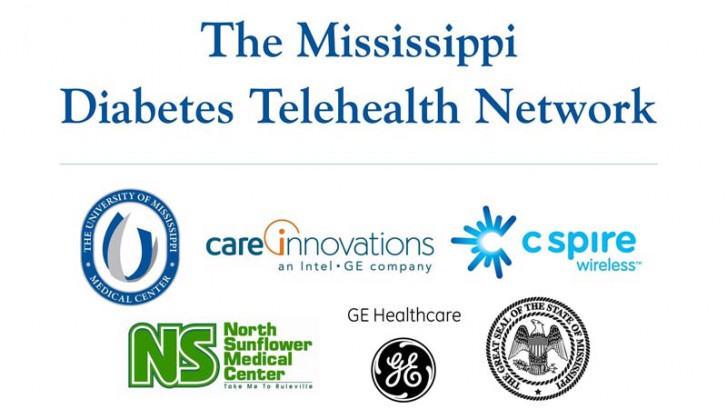
The Diabetes Telehealth Network is only 90 days old, but talk of taking it global has already started.
The pilot program uses telehealth to treat diabetes patients in the Mississippi Delta. Care is administered by doctors at the University of Mississippi Medical Center in partnership with North Sunflower Medical Center in Ruleville.

A population healthcare model in Mississippi that leverages telehealth technology to help curb diabetes has achieved early success and caught the attention of state officials who are part of the public-private partnership.
Mississippi Gov. Phil Bryant and FCC Commissioner Mignon Clyburn visited the North Sunflower Medical Center in Ruleville, Miss. earlier this week as part of a continuing public-private partnership to address the growing diabetes crisis that affects more than 370,000 adults in Mississippi and 29.1 million people nationwide.
The program, which was designed to improve the health of participants as well as reduce the cost of care, provided state-of-the-art fixed and mobile broadband connections.
In 2010, 12.1 percent of adults in the Mississippi Delta, which is among the more underserved and impoverished regions in the nation, reported being diagnosed with type 2 diabetes. Of that group, 293 died from complications related to the disease. In 2012, diabetic medical expenses in Mississippi totaled $2.74 billion, according to the American Diabetes Association.
This past January the state partnered with the University of Mississippi Medical Center, North Sunflower Medical Center, GE Healthcare, Intel-GE Care Innovations, and C Spire to provide people with diabetes more consistent and timely access to clinicians through the use of telehealth technology in their homes. The program, known as the Diabetes Telehealth Network, aims to enroll up to 200 patients.
“It is very encouraging to see positive results early in the program and hear the personal stories from patients and nurses who believe this program has the ability to create lasting change for individuals and the state of Mississippi,” Bryant said during his visit to the North Sunflower Medical Center. “This innovative partnership has gained the attention of the Federal Communications Commission as we are connecting patients in the rural town of Ruleville to a care management program they otherwise would not have access to in their town.”
The Diabetes Telehealth Network began recruiting patients in August in the Mississippi Delta to participate in an 18-month remote care management program, a concept that fuses technology with UMMC specialists to improve patient outcomes in an underserved area of the state. The program – a first of its kind nationally – is intended to forge a stronger connection between people with diabetes and clinicians in a way that supports earlier clinical intervention, more effective use of health services, and creates positive health habits and behavior change.
Participants in the Diabetes Telehealth Network received tablets powered by a Care Innovations telehealth solution that enables healthcare providers to remotely manage patients with chronic conditions. With their tablets, patients share what’s going on with them physically, emotionally and psychologically through daily health sessions with their clinicians. In addition, the tablets automatically capture their health data, such as weight, blood pressure and glucose levels, and transmit that daily to clinicians.
Using telehealth technology, clinicians can better engage and educate patients, easily adjust medical care plans, schedule phone calls or video chat with patients. C Spire provides the high-speed mobile broadband communications network needed to support the connection between patients and clinicians in even the most remote parts of Mississippi.
“Connecting people to the health and care services they need is the true promise of broadband,” said Clyburn, in a press statement. “I applaud the State of Mississippi and its private partners for making this project a priority. The Diabetes Telehealth Network is a terrific example of the value of the ubiquito
“Just four months into the program, we’re already hearing such great patient feedback about how the Diabetes Telehealth Network is empowering patients to take better control of their diabetes from their home, yet still have the guidance and oversight of clinicians,” said Kristi Henderson, DNP, UMMC’s chief telehealth and innovation officer. In a news release. “This program is helping improve care coordination and strengthen connections between clinicians and patients beyond the walls of a hospital in a way that I think will reduce the use of higher acuity clinical settings, like the ER.”
“Our clinicians have expressed the ease of use with the technology to better manage patients and help coordinate the care they need,” said NSMC Executive Director Billy Marlow. “It’s rewarding to be a part of something that really makes a difference in peoples’ lives, and we are proud of what we have accomplished with the partners thus far.”
Article courtesy of Bernie Monegain at Healthcare IT News.
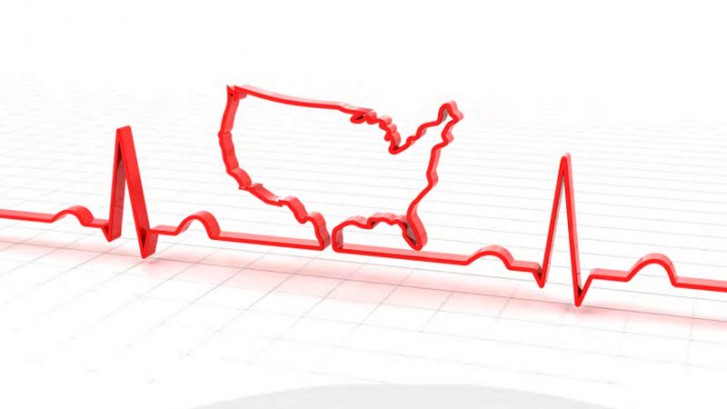
Here’s something you don’t often hear: Mississippi has received an A rating in a health care category.
Mississippi is one of only seven states to receive an A from the American Telemedicine Association in a report released Monday.
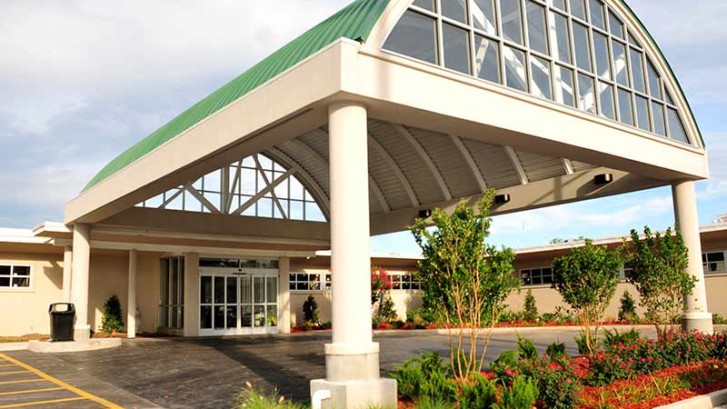
Walt Grayson has another story about people who are making a difference for other people, this time from the Delta town of Ruleville.
We start at North Sunflower Medical Center, a hospital that has come back from the brink of extinction, and is bringing the whole community back with it.
It is a thriving critical care facility today, with an emergency room and a nursing home and a wellness center and a clinic that sees over 5000 people a month. And yet just six years ago, this facility was only moments away from closing.
That’s the condition it was in when Billy Marlow was promoted from a member of the board of directors, to Chairman of the Board, to acting administrator, all in short order.
Billy Marlow, the Executive Dir. of NSMC, Ruleville says, “We had about eight hours of cash on hand with a lot of debt and no patients.”
Through a lot of effort, determination, and primarily not knowing they couldn’t do this, they saved the hospital and more.
Joanie Perkins, Chief Development Officer, NSMC tells part of what they have done.
“We rank number one in patient satisfaction in the state of Mississippi and in the top 10 in the nation, of all hospitals, not just critical access. We are the cleanest facility and we have the nicest employees.”
That “cleanest” designation is by actual statistics, and the “nicest employees” is a matter of opinion, but stands to reason if you have all of the other accolades. But it was a mess when Billy Marlow took it over.
Billy says, “I did a survey the first thing I did was, ‘Tell me what’s wrong. Tell me how to fix it.’ And really the employees fixed this.”
Well, the fixing didn’t stop there. As much as the hospital has improved, so has the town of Ruleville, because the hospital has invested in the city.
Robin Marlow, NSMC Dir. of Community Relations says, “The North Sunflower has obtained several buildings downtown to create different businesses. We have Sunflower Dental Clinic, Sunflower Eye Station, The Diagnostic Center, which is digital mammograms.”
And a bunch more.
To the extent that this little hospital by all rights should have ceased to exist years ago. And if it had, what was left of the community would have followed. But it didn’t because of the employees, yes, but also because of Billy Marlow who thought they’d fix it rather than let it go. And in so doing, has made a difference for the thousands of patients who are treated here every year, for the 500 plus employees who work here, and the town of Ruleville, all defying the odds and not only surviving, but thriving.

Mississippi faces a growing diabetes crisis, ranking second among all states nationwide in disease prevalence with more than 373,000 adults in the state living with some form of diabetes.

As part of its mission to become the first critical access hospital in Mississippi to demonstrate meaningful use of electronic health record (EHR) technology, North Sunflower Medical Center plans to deploy a suite of McKesson information technology solutions. The new systems will replace paper-based records and disparate technologies and address duplicate data entry challenges with communications capabilities designed to automate outdated manual processes and better coordinate care.
“These two systems offer a winning combination for North Sunflower Medical Center and community healthcare providers across the country”
The deployment includes McKesson’s Paragon® health information system (HIS) , Practice Partner® EHR solution and RelayHealth claims and eligibility processing solutions, as well as workforce management to enable efficient staff scheduling. The rural medical center, which serves the Mississippi Delta region, expects to use this technology to dramatically simplify clinical and business operations while improving preventative care and patient safety.
With the new systems, North Sunflower’s 20 physicians, 24 mid-level practitioners, and authorized medical billing and support staff will have secure, “anywhere, anytime” access to complete patient records at their fingertips. Exam room notes in physician practices will update the patient’s chart automatically. Patients will be able to view their electronic health record, request prescription refills, pre-register, track treatments and communicate with their physicians via a secure Internet connection.
The technology is also intended to streamline workflows for North Sunflower’s medical teams and provide seamless integration across the medical center. McKesson’s information technology (IT) will play an important role at North Sunflower’s 25-bed hospital and community clinic, where practitioners treat a combined 2,600 patients per month, as well as its new 30,000 square foot wellness center. Doctors and nutritionists at the new facility will emphasize proactive and preventative care for the chronically ill.
“This strategic initiative with McKesson enables us to embark on a whole new level of big-hospital healthcare in one of the most economically challenged communities in the country,” said Joanie Perkins, director of network development for North Sunflower Medical Center. “Our new systems are designed to provide a safety net under every nurse, physician, pharmacist and patient, with unprecedented information access and sharing capabilities that will support high-quality, safe healthcare.”
The technology will allow clinicians to more easily share the collective results from diabetes and cardiovascular patient studies and reports with people who live in communities throughout Sunflower County. The medical center believes that patients will be more engaged in improving their own health once they see statistics that show the impact exercise and healthy diets can have on their lives.
“We’re taking advantage of a once-in-a-lifetime stimulus opportunity to invest in our future and the future of our community with the best healthcare IT solutions available today,” Perkins said. “We are determined to remain a healthcare leader in Mississippi and, with McKesson’s IT expertise, we believe we can set the standard for quality of care.”
“These two systems offer a winning combination for North Sunflower Medical Center and community healthcare providers across the country,” said Jim Pesce, president, Paragon, McKesson Provider Technologies. “Anywhere, anytime access to electronic health records and comprehensive chronic care data opens up a new world of healthcare productivity and connectivity, as well as life-changing care for the people of Sunflower County.”